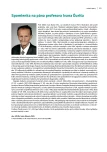Specifics of using ambulatory blood pressure monitoring in the elderly
Authors:
Ľudovít Gašpar; Ivan Balažovjech; Boris Krahulec
Authors‘ workplace:
II. interná klinika LF UK a UN Bratislava, Slovenská republika, prednosta doc. MUDr. Ľudovít Gašpar, CSc.
Published in:
Vnitř Lék 2015; 61(Suppl 5): 21-24
Category:
Reviews
Overview
Arterial hypertension is a chronic disease which represents a major risk factor for damage of cardiovascular system. Insufficient control of elevated blood pressure is associated with the development of target organ damage, increased cardiovascular morbidity and mortality with a adverse prognostic value. Using ambulatory blood pressure monitoring (ABPM) we can improve the overall management of elderly patients at which the prevalence of arterial hypertension is particularly high.
Key words:
ambulatory blood pressure monitoring (ABPM) – cardiometabolic risk factors – diurnal index – chronopharmacological aspects – management of arterial hypertension
Sources
1. Mottillo S, Fillon KB, Genest J et al. The metabolic syndrome and cardiovascular risk a systematic review and meta-analysis. J Am Coll Cardiol 2010; 56(14): 1113–1132.
2. Sierral A, Segura J, Gorostidi M et al. Diurnal blood pressure variation, risk categories and antoihypertensive treatment. Hypertens Res 2010; 33(8): 767–771.
3. Anzal M, Palmer AJ, Starr J et al. The prevalence of pseudohypertension in the elderly. J Hum Hypertens 1996; 10(6): 409–411.
4. Rocha E, Mello e Silva A, Gouveia-Oliveira A et al. Isolated systolic hypertension – epidemiology and impact in clinical practice. Rev Port Cardiol 2003; 22(1): 7–23.
5. Řiháček I, Souček M, Fráňa P et al. Ambulantní monitorování krevního tlaku. Remedia 2008; 18(2): 133–136.
6. Hansen TW, Jeppesen J, Rasmussen S et al. Ambulatory blood pressure and mortality. A population-based study. Hypertension 2005; 45(4): 499–504.
7. Mancia G, Fagard R, Narkiewicz Ket al. The Task Force for the management of arterial hypertension of the European Society of Hypertension (ESH) and of the European Society of Cardiology (ESC). 2013 ESC/ESH guidelines for the management of arterial hypertension. J Hypertension 2013; 31(7): 1281–1357.
8. Flegul KM, Graubard BI, Wiliamson DF et al. Cause-specific excess deaths associated with underweight, overweight, and obesity. JAMA 2007; 298(17): 2028–2037.
9. Go AS, Mozzafarian D, Roger VL et al. Heart Disease and Stroke Statistics—2014 Update. A Report from the American Heart Association. Circulation 2014; 129(3): e28-e292. Dostupné z DOI: <http://dx.doi.org/10.1161/01.cir.0000441139.02102.80>.
10. Narkiewicz K. Obesity and hypertension – the issue is more complex than we thought. Nephrol Dial Transplant 2006; 21(2): 264–267.
11. Patel BM, Metha AA. Aldosterone and angiotensin: Role in diabetes and cardiovascular diseases. Eur J Pharmacol 2012; 697(1–3): 1–12.
12. Bonora E. The metabolic syndrome and cardiovascular disease. Ann of Med 2006; 38(1): 64–80.
13. Gašpar Ľ, Balažovjech I. Rezistentná hypertenzia v staršom veku. Vnitř Lék 2013; 59(6): 459–462.
14. Redon J, Cifkova R, Laurent S et al. The metabolic syndrome in hypertension: European society of hypertension position statement. J Hypertens 2008; 26(10): 1891–1900.
15. Biaggioni I. Circadian clocks, autonomic rhythms, and blood pressure dipping. Hypertension 2008; 52(5): 797–798.
16. Gavorník P, Dukát A, Gašpar Ľ et al. Manažment dyslipidémií – prítomnosť a budúcnosť. Odporúčania Sekcie angiológov Slovenskej lekárskej komory (2013). Vnitř Lék 2013; 59(10): 932–938.
17. Skultetyova D, Filipova S, Madaric J et al. Evaluation of carotid artery stiffness and flow-mediated vasodilation in patients with resistant hypertension after renal sympathetic denervation. Cardiology Lett 2014; 23(3): 215–222.
18. Gavorník P. Multivariabilita orgánovovaskulárnych chorôb. In: Gavorník P. Angiológia 2 pre všeobecných lekárov. Dr. Josef Raabe: Bratislava 2014: 119–122. ISBN 978–80–8140–168–8.
19. Hansen TW, Li Y, Boggia J et al. Predictive role of the nighttime blood pressure. Hypertension 2011; 57(1): 3–10.
20. Verdechia P, Angeli F, Mazzotta G et al. Day-night dip and early-morning surge in blood pressure in hypertension: Prognostic implications. Hypertension 2012; 60(1): 34–42.
21. Kriška M Zlyhanie farmakoterapie. Možnosti prevencie. Bratislava: SAP 2015. ISBN 978–80–8960733–4.
22. Souček M, Kára T. Klinická patofyziologie hypertenze. Grada: Praha 2002. ISBN 80–247–0227–4.
23. Logan AG. Hypertension in aging patients. Expert Rev Cardiovasc Ther 2011; 9(11): 113–120.
Labels
Diabetology Endocrinology Internal medicineArticle was published in
Internal Medicine

2015 Issue Suppl 5
Most read in this issue
- Are we to pay attention to factor XII deficiency?
- Diagnostics of polycystic ovary syndrome
- Arterial hypertension – multicirculus vitiosus vasorum
- Hormonal changes in inflammatory bowel disease
